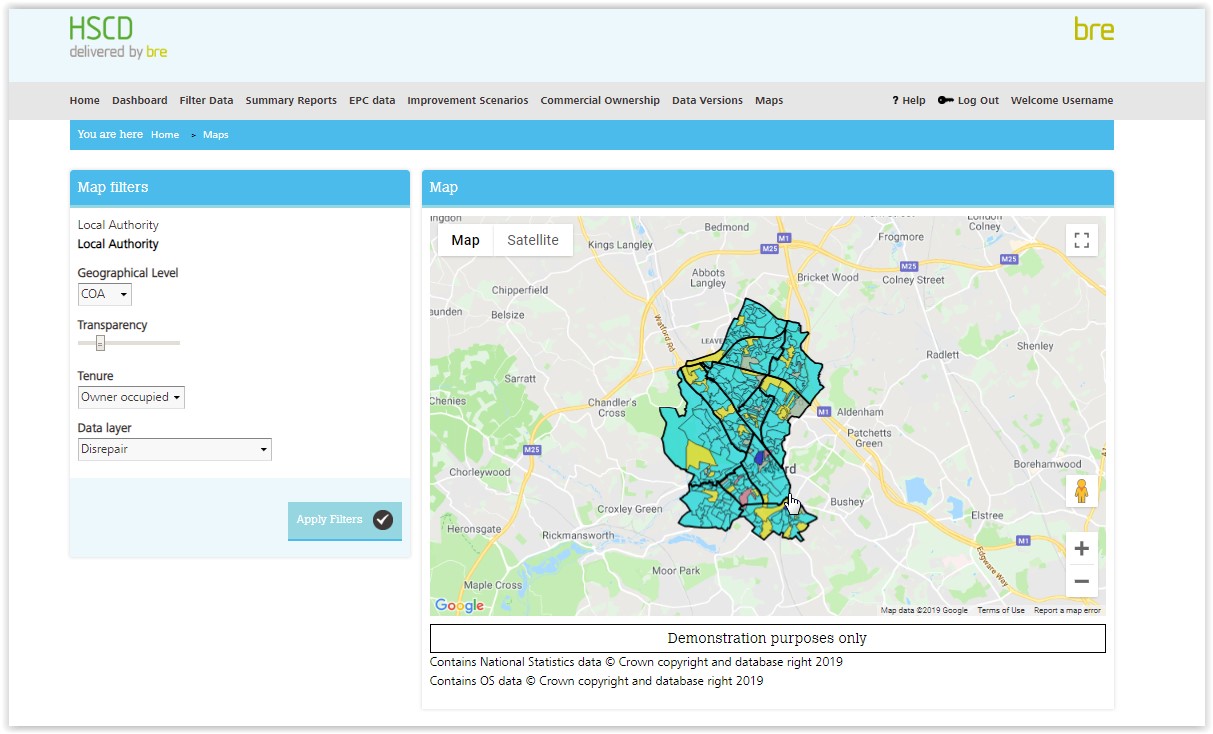HSCD Commercial Ownership and Rogue Landlords
In “Digital Detectives – Accurate Information is the Key to Enforcement” our colleague Ian Watson highlighted how the HM Land Registry ownership data can help local authorities identify social landlords and take appropriate action against the so-called rogue landlords.
We have since developed a feature in our online tool HSCD (Housing stock Condition Database) that allows local authorities to query the Commercial and Corporate Ownership and Overseas Companies Ownership datasets, as well as identifying the residential properties in their local area that are corporately owned.
In addition, we are able to inform tenure and identify potential rogue landlord activity.
The Housing and Health team is now taking a step further and developing an additional feature that will allow local authorities to keep up to date with the changes of ownership of dwellings in their housing stock on a monthly basis.
From 1st November, all our customer will have access to ownership monthly updates on a 3-month trial basis.
Join us on 22nd October at 10 am to find out more about the trial and review recent projects that have used this data by registering here.
More information on rogue landlord enforcement can be accessed in “Rogue Landlord Enforcement Guide for Local Authorities”.
HSCD Online maps – 12 month trial
 To help our customers better understand their data, we have recently made available our new mapping feature. This feature allows HSCD users to visualise their data at different geographical levels, different tenures and for different property indicators against the familiar Google Map background. The different coloured areas are clickable allowing the user to query the background data for further analysis at dwelling level for the indicators selected. This feature makes it easier to investigate and analyse your organisation’s housing stock at various geographical levels.
To help our customers better understand their data, we have recently made available our new mapping feature. This feature allows HSCD users to visualise their data at different geographical levels, different tenures and for different property indicators against the familiar Google Map background. The different coloured areas are clickable allowing the user to query the background data for further analysis at dwelling level for the indicators selected. This feature makes it easier to investigate and analyse your organisation’s housing stock at various geographical levels.
Our customers have access to this online map feature on a 12 month free trial. If you are one of our customers, log in to the HSCD and access the “Map” tab for a glance. If you aren’t a customer, feel free to get in touch for a chat and we will be happy to enable the 12-month trial for you when you become a customer. In any case, if you would like to simply explore the feature, you can always do so by signing up for a demo.
ECO3
The Energy Company Obligation (ECO) is a government energy efficiency scheme in Great Britain which aims to help reduce carbon emissions and tackle fuel poverty. ECO requires energy companies to assist in the installation of energy efficiency measures to low income and vulnerable households or those living in hard-to-treat (HTT) properties. Under the ECO, energy companies are obliged to meet targets expressed as carbon or costs saved. There have been several ECO schemes to date, with the new scheme starting in October 2018:
- ECO1 – ran from January 2013 to March 2015
- ECO2 – launched on 1 April 2015 and ended on 31 March 2017
- ECO2t – was an 18-month extension to the ECO2 scheme until September 2018 as a transition period between the end of ECO2 and a new scheme.
- ECO3 launched in October 2018 and will run for 3.5 years to the end of March 2022
ECO3 focusses exclusively on those with lower income backgrounds, considered to be in vulnerable situations or living in fuel poverty. It aims to make energy-saving improvements to 900,000 homes, replace broken heating systems in 35,000 homes and treat 17,00 homes with solid walls. Rural areas must receive 15% of ECO measures and 10% of measures can be installing ‘innovative’ products, such as devices to help homeowners manage their energy use.
Uniquely to ECO3, those receiving Child Benefit and disability benefits are eligible. You may also be eligible for help with insulation or installing a gas boiler or heating system if you’re a social housing tenant and in a home with an energy-efficiency rating of E, F or G.
You can also read our detailed impact assessment and a thorough overview.
English Housing Survey 2017-18
The “English Housing Survey 2017 to 2018: Households” report was published 17th July 2019 and outlines the characteristics of households and how this varies by tenure and dwelling type. It also examines how personal wellbeing varies depending on the condition and type of dwellings. Main findings highlight 1-in-5 households live in flats, with certain social groups showing a greater tendency to accommodate high rise flats. Greater well-being was displayed in owner-occupied accommodation and improved quality of life was seen in dwellings meeting the Decent Homes Standard. For more information read the results and full report of the “English Housing Survey 2017 to 2018: Households” and the English Housing Survey Headline Report.
Non-Decent Homes Guide
Written by Care & Repair England, the Non-Decent Homes Guide was released in June 2019, drawing on experiences of members of the Older People’s Housing Champions. BRE’s Housing Stock Performance team presented the level of disrepair in the English housing stock and necessary actions to improve the status of existing homes. A dwelling is defined as ‘non-decent’ according to a set of technical measures, including whether a dwelling has specific hazards that pose a threat to occupants’ health or safety (HHSRS), is in a reasonable state of repair, has reasonably modern facilities and has efficient heating and insulation, amongst other factors. The 2017 English Housing Survey report shows 19% of dwellings are non-decent, a decrease from 35% in 2007, with the majority being owner-occupied dwellings. BRE has carried out extensive modelling and analysis of the health impacts and costs to the NHS from poor housing. It is estimated to cost the NHS £2.4 per annum. Local Authority mitigation measures to maintain decent housing standard includes carrying out ‘appropriate enforcement action’, set out under housing Act 2004, for all dwelling types. Read the full Non-Decent Homes Guide, and the factsheet and infographic manifesto.
Centre for Ageing Better and Care & Repair England collaboration
Care & Repair England has collaborated with the Centre for Ageing Better to tackle non-decent housing across England and improve existing housing quality for an ageing population. Ageing Better has previously pledged to remove hazardous conditions in 1 million homes and this new collaboration will last a minimum of three years. For further information visit the Ageing Better website.
Cold Home Identification
As we see our summer weather coming to an end, we begin preparations for the cold months ahead. Local Authorities will begin to see an increase in damp and mould and excess cold complaints which require input from environmental health professionals to engage with tenants, landlords and owner-occupiers to remedy these health hazards.
During the winter period of 2017/18, there were an estimated 50,100 excess winter deaths in England and Wales, the highest recorded for 41 years. With the continuation of ECO3, and other relevant warm home schemes such as the Warm Homes Fund, Local Authorities can provide support to residents, ensuring they have warm homes that promote health and wellbeing in the colder months. These schemes have seen an increase in the presence of joint working between Housing and Public Health, demonstrating the clear links between health and housing.
BRE has a range of services available to support Local Authorities throughout the year, however, many of our services can be valuable to clients focusing on a cold-weather intervention programme, such as home energy efficiency schemes or targeted intervention work amongst low-income households at risk of living in cold homes.
BRE’s housing stock modelling services draw on a range of commercial datasets to provide dwelling level data for a range of housing indicators such as HHSRS Excess Cold Category 1 hazards, Low Income Households, Fuel Poverty (both 10% and Low Income High Costs), enabling Local Authorities to export lists of dwellings for targeted intervention through the provision of BRE’s Housing Stock Condition Database (HSCD). A 3-month demo account of HSCD, which can demonstrate the ability to export lists and investigate dwellings, can be accessed by visiting the website.


The Excess Cold Calculator (XCC) assists Environmental Health Practitioners and Technical Officers in the assessment of the Excess Cold hazard in dwellings. Users enter information about a dwelling and its occupants and the calculator provides estimated running costs and information on the adequacy of the heating system.
The calculator has many benefits to local authorities, including:
- Informing decisions about the necessary remedial actions in enforcement cases
- BRE endorsed evidence for RPT hearings
- Assisting in discussions with landlords about works required
- May help avoid tribunal hearings by making the reasons for enforcement action clearer to landlords
- Heat loss calculator for individual rooms to assist in specifying radiator/storage heater sizes
- Can be used to determine if remedial actions are cost-effective
- The tool can be re-run to test different improvement scenarios
BRE’s 8 home improvement scenarios can be applied to a dwelling to assess the impact of specific home improvement measures. The impact is measured on a range of outputs such as Heat Cost, Heat Demand, Energy Demand, SimpleSAP ratings and SimpleCO2, the latter which has particular relevance in light of the Carbon Zero by 2050 agenda – enabling Local Authorities to determine how specific improvements can reduce a dwelling’s carbon emissions.
Essentially, BRE has a range of services available to support Local Authorities to plan and promote targeted intervention schemes and programmes across cold homes, disrepair and hazards to health without placing further demand on the team resources.
Smart Cities Live – Retrofitting 2019
On 7th November Housing and Energy Director, John Riley will be representing BRE at SCL – Retrofitting 2019. The event addresses the issue that making incremental changes to older housing stock will not be sufficient to meet climate change targets. Now is the time for building owners and housing associations to take a step towards deep retrofitting their housing and building stock. Discussion topics include solar power, smart buildings, heating and ventilation, green funding and policy, and carbon reduction. Visit Smart Cities Live for more information on the conference and future events.
Get to know our team
Fiona’s background is in Environmental Science and she is a Senior Consultant and Technical Editor in the Housing and Health team with over 20 years’ experience in the industry. In her current role she is primarily responsible for writing and editing the team’s reports as well as data analysis, policy research and project management. She also has experience working on the English Housing Survey (EHS), writing the 2016 Stock Condition report. Fiona previously worked in the Strategy Assessment and Evaluation team principally working on the development of the Non-Domestic Energy and Emissions Model (N-DEEM) which is widely used to assess the potential for reducing the UK’s carbon emissions. She has also worked on a number of other projects including work for DECC on the analysis of energy and carbon emissions on the Government Estate as well as work on the Green Deal. Fiona undertook a 3 month part-time secondment to DECC in 2012 to assist with developing the non-domestic Green Deal policy.
Papers and Publications
Watson I, MacKenzie F, Woodfine L and Azam S, Making a Difference. Housing and Health: A Case for Investment, Public Health Wales, Cardiff, 2019
MHCLG, English Housing Survey: Stock Condition, 2016, published 2018
C Pout, F MacKenzie, Information Paper IP3/12: Potential for reducing carbon emissions from commercial and public-sector buildings, IHS Press, London, 2012
F MacKenzie, C Pout, L Shorrock, A Matthews and J Henderson, Energy efficiency in new and existing buildings: Comparative costs and CO2 savings, IHS Press, London, 2010
C H Pout, F MacKenzie and R Bettle, Carbon dioxide emissions from non-domestic buildings: 2000 and beyond, CRC London, 2002
C Ni Riain, J Fisher, F MacKenzie and J Littler, BRE’s Environmental Building: Energy Performance in Use, Presented at CIBSE conference, Dublin, September 2000
Finally – keep in touch
We want to keep you updated on what’s new in the world of housing and health, as well as provide an insight into some of the work our customers have been doing. Please go to our online preference centre and opt-in to receive regular communications from BRE. Additionally, if you have specific queries please e-mail us at [email protected] and for more information on our services go to https://wpe.bregroup.com/housingstock.
